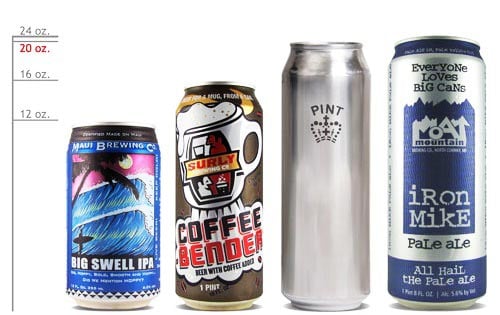Start 14-Day Trial Subscription
*No credit card required

The Most Popular Beer Sizes in Cans, Glasses, Kegs and More
Discover the world of beer serving sizes and vessels! From pint glasses to cans, bottles to kegs, unravel the confusion with our guide to the most popular beer sizes. Learn about the various glass shapes and sizes that enhance your beer-drinking experience.
From one bar to the next, there’s little consistency in what a serving of beer might look like. Serving sizes and the vessels they come in can be confusing even for a seasoned beer drinker, so how a beer shows up in front of a customer can be intimidating and puzzling. Beer lovers argue over whether a shaker pint is acceptable for a beer, or they may insist on nonic pints, snifters or tulips. Cans and bottles offer a variety of different serving sizes for consumption at home, and breweries produce barrels of beer – though that is a different measurement than the wooden whiskey barrels and kegs that often make their home within breweries and restaurants alike. To help clear up any confusion, here's a closer look at the most popular beer sizes you'll find among cans, bottles, kegs and more.
Glass Sizes
Breweries will more often than not pour their beers out of serving tanks and kegs through a draft system into glasses. These different types of beer glasses will vary in size and are often somewhat based on a beer’s alcohol content. Here's a nice review of the best beer mugs from Kitchenistic if you are looking for one.
As breweries and consumers become more sophisticated in their beer knowledge, the glass variations are expanding to fit certain types of beers and accentuate their aromas and flavors, but these three sizes are most likely to be found at your neighborhood brewpub.
4 oz.
If a brewery is offering flights of beers, it’s a good bet the flight will come in 4-ounce servings. The size is convenient as four samples equals one pint, the most common offering for a bar’s beer menu.
8 oz.
For higher-ABV beers, 8 ounces is a logical serving size for bars. Those smaller glasses for higher alcohol brews almost always come in the form of a tulip glass or snifter, and the exact sizes can vary a little bit.
16 oz.
A pint is the standard measurement for beer. A lot of bars will serve virtually all beers in a pint glass, but as the average beer consumer learns more about glassware, so too do restaurants. Still, “I’ll have a pint,” will remain a universal request for a beer. An imperial pint in Europe and Canada is 20 ounces, 4 more than American pints, which just adds to the confusion. Pint glasses are also available in flat-sided "standard" glasses or "nonic" glasses, which have a small ridge halfway up the glass for aroma.
Shapes of Beer Glasses
There is a smorgasbord of beer glasses available to connoisseurs. While everyone might have a favorite beer glass, a few of the many options include:
American Pint Glass
A standard pint glass that can serve anything from cocktails to beers to sodas to waters. Found in pretty much every restaurant in America, one way or another.
Stange Glasses
Created in Germany for the refreshing and delectable German kölsch style, this straight-walled glass looks terrific and works well for lighter lagers as well as for housing its namesake kölsch.
Thistle Glass
A modified tulip glass, this striking glass is best employed when sipping Scottish ales. The pronounced bulb shape atop the stem and the light flare atop the glass will help the peaty, rich aromas and flavors pour forth.
Goblet and Chalice
Similar in size, shape and design, these two glasses are like wine glasses except with a wider base and a thicker stem.
Pilsner Glass
Tall, slender and slightly curvy, these glasses work perfectly for low-ABV summer sippers.
Beer Stein
The classic delivery system for large portions of German brews at Oktoberfest, this beer holder can be made from a variety of materials, including porcelain, pewter, stoneware and, of course, glass.
Snifter Glasses
Typically reserved for whiskey, the snifter glass is also perfect for myriad beer styles, including Belgian ales, stouts and even IPAs!
Weizen Glass
Similar in shape to pilsner glasses, weizen glasses have more curvature to them, especially at the top. Use this glass to enjoy delectable wheat beers and saisons.

Can Sizes
Cans once had a bad rap among craft beer consumers who were still in rebellion of anything associated with macro lagers. Cans have experienced a massive renaissance over the past decade with more brewers shifting to the aluminum container. There’s a general consensus that cans provide more protection against light and oxidation than their glass counterparts, allowing beer to age more gracefully.
8.4 oz.
This "nip can" is a more compact version of the typical 12-oz. can. Though rare, you'll see 21st Amendment's Lower De Boom Barleywine and the Rodenbach Fruitage sour ale in this tiny container. Compact and easily transportable, this container is perfect for small snifters on the beach or for a little tipple during a camping trip.
12 oz.
A can of beer, for much of mainstream can history, is 12 ounces. Short and compact, a 12-ounce can matches the recommended serving size of beer. Cans of this size come in a range of packs, including 6-, 12-, 15-, 18-, 24- and 30-packs.
16 oz.
Pint cans have surged with the rise of craft beer. More common now than ever before, they offer a full pour of a pint glass. Most often found in 4-packs, pint cans have seen their popularity grow as a way for brewers to showcase their beers in attractive new formats.
19.2 oz.
A relatively new entry to the can world, the 19.2-ounce “stovepipe” can offers craft brewers an "in" at convenience stores and gas stations. Not quite a tall boy in the classical macro sense, the 19.2-ounce can experienced the largest growth of packaged sales from 2015-2017 according to IRI data, with Oskar Blues Brewery and Terrapin Beer Co. leading the way in usage of this container.




Comments
Pages